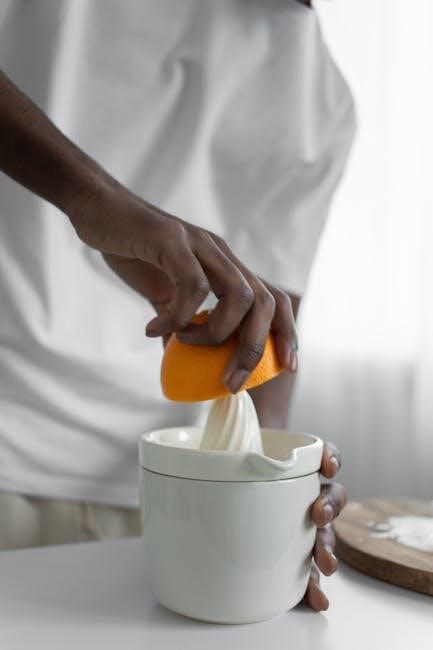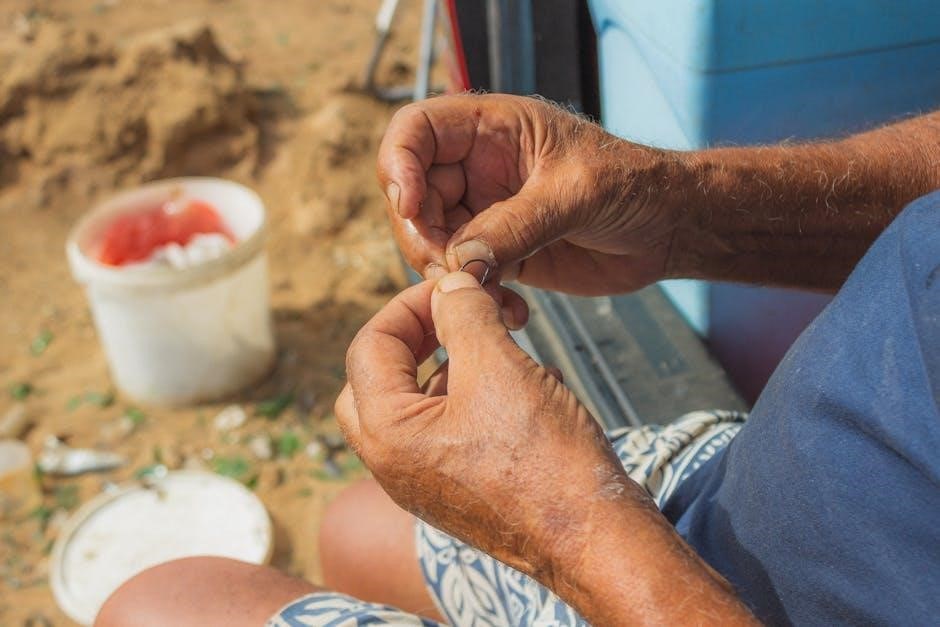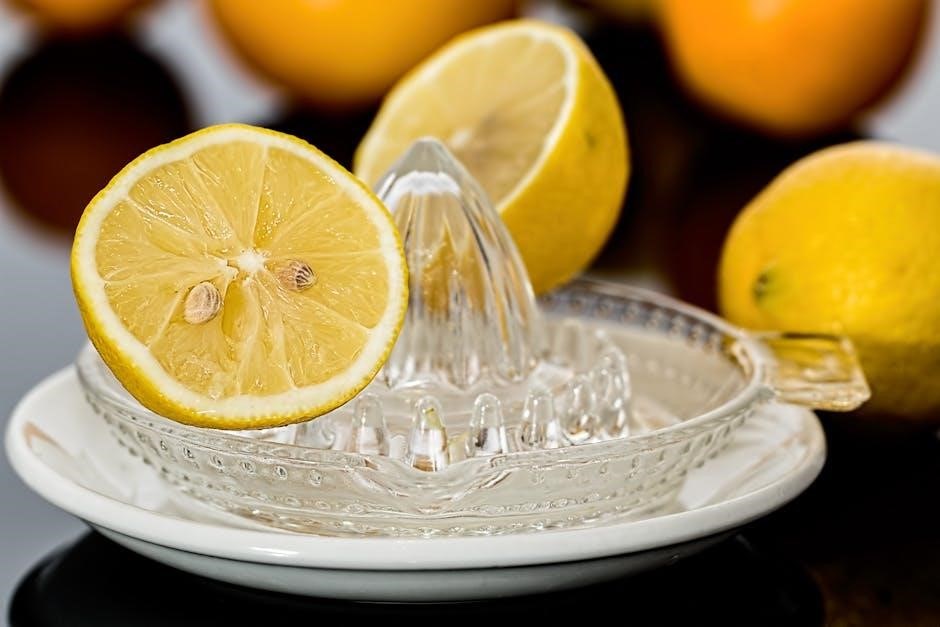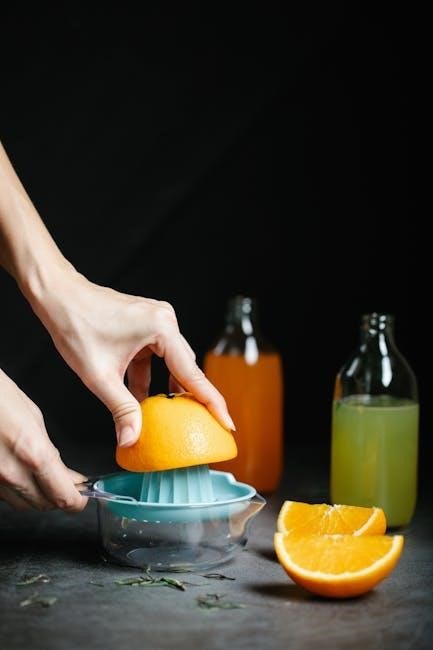Welcome to the Hamilton Beach Juicer Manual! This guide covers essential information for models like the 67500 and 67608, ensuring safe and effective juicing experiences․
1․1 Overview of the Hamilton Beach Juicer Models
Hamilton Beach offers a variety of juicer models, including the 67500, 67608, and 67702, each designed for efficient juice extraction․ These models feature large feed chutes, removable pulp bins, and easy-to-use interfaces․ The 67608, for instance, includes a drip-free spout for mess-free pouring․ All models are built for durability and user convenience, catering to both beginners and experienced juicers․ Each juicer comes with detailed manuals providing step-by-step guides for assembly, operation, and maintenance․
1․2 Importance of Reading the Manual
Reading the Hamilton Beach Juicer Manual is essential for safe and effective use․ It provides detailed instructions for assembling, operating, and maintaining your juicer․ The manual includes safety guidelines, troubleshooting tips, and optimal juicing practices․ Understanding the manual ensures you avoid potential hazards and get the most out of your appliance․ It also covers specific features of models like the 67608 and 67500, helping you master their unique functions and settings for the best juicing experience․

Safety Precautions
Always read the manual before use․ Place the juicer on a dry, level surface and avoid hot areas․ Never leave it unattended while operating․ Blades are sharp, handle with care․ Proper assembly is crucial for safe functioning․ Follow all safety guidelines to ensure a safe and enjoyable juicing experience․

2․1 General Safety Guidelines
Always place the juicer on a dry, level surface away from hot surfaces․ Ensure the unit is properly assembled before use․ Never leave the appliance unattended while in operation; Keep children and pets away from the juicer․ Avoid overhanging cords near edges․ Handle sharp blades with care․ Do not operate the juicer if it is damaged․ Follow all safety instructions provided in the manual to ensure a safe and enjoyable juicing experience․
2․2 Specific Hazards and Warnings
Be aware of sharp blades and avoid touching them․ Never insert hands or utensils into the chute during operation․ Ensure proper assembly to prevent motor damage․ Avoid juicing avocado or banana, as they can clog the machine․ Do not use the juicer near water or in humid environments․ Keep the appliance away from hot surfaces․ Always unplug the juicer before cleaning or performing maintenance․ Failure to follow these warnings may result in injury or damage to the device․

Assembly and Parts Identification
Begin by unpacking and inventorying all components, including the motor base, feed chute, and strainer basket․ Refer to the manual for accurate identification and assembly guidance․
3․1 Unpacking and Inventory of Components
Begin by carefully unpacking your Hamilton Beach Juicer, ensuring all components are included․ Typically, you’ll find the motor base, feed chute, strainer basket, pulp bin, and juice container․ Check each part against the packing list to confirm completeness․ Handle sharp components like the cutter and strainer with care․ Inspect all parts for damage and ensure they are clean before assembly․ Familiarize yourself with each piece to understand its function, as outlined in the manual․ This step is crucial for safe and proper assembly․
3․2 Step-by-Step Assembly Instructions
Start by placing the motor base on a stable, flat surface․ Align the cutter and strainer basket, ensuring they fit securely onto the motor base․ Next, attach the feed chute by locking it into position․ Place the pulp container at the rear of the motor base and ensure it is properly aligned․ Finally, plug in the power cord and test the juicer at low speed to confirm smooth operation․ Follow the manual for precise alignment and assembly details․
Operating the Juicer
Plug in the juicer, place a glass under the spout, and ensure all parts are securely assembled․ Feed fruits and vegetables through the chute, then adjust settings for optimal extraction․
4․1 Plugging In and Powering On
Before operating, ensure the juicer is properly assembled․ Plug the cord into a 120-volt AC outlet and place a glass or container under the spout․ Turn the ON/OFF switch to the “ON” position to start the motor․ Always ensure the unit is stable and on a dry, level surface․ Avoid letting the cord hang over edges or touch hot surfaces․ Follow these steps carefully to begin juicing safely and effectively․
4․2 Feeding Fruits and Vegetables
Feed fruits and vegetables into the juicer through the chute, ensuring they fit securely․ For larger items like apples, cut them into smaller pieces to avoid clogging․ Place the pulp container under the spout to collect residue․ For leafy greens, compact them into tight bunches before feeding․ Avoid overloading the chute, as this can cause jamming․ Always feed ingredients slowly and steadily to maintain even extraction․ This ensures optimal juicing performance and prevents motor strain․
4․3 Controlling the Juicer Settings
Turn on the juicer by flipping the toggle switch․ Adjust the settings based on the type of ingredients․ For harder fruits or vegetables, use the higher speed setting, and for softer or leafy greens, switch to the lower speed․ Monitor the pulp container and adjust the feed rate to avoid clogging․ Use the juicer’s controls to ensure smooth operation and optimal juice extraction․ Refer to your model’s manual for specific setting options, as features may vary․
Cleaning and Maintenance
Clean the juicer after each use by disassembling and washing parts with warm soapy water․ Rinse thoroughly and dry to prevent rust․ Regularly check for wear․
5․1 Disassembling the Juicer for Cleaning
To disassemble the juicer, start by unplugging it and allowing it to cool․ Remove the pulp bin and juice container, then carefully detach the strainer basket and blades․ Separate all parts, including the motor base and spout, ensuring they are free from pulp․ Rinse each component under warm water or soak to loosen stubborn residue․ After cleaning, lay all parts out to dry thoroughly to prevent moisture buildup and maintain hygiene․ Regular disassembly helps prevent rust and bacterial growth․
5․2 Cleaning Each Component
After disassembling, wash each part with mild soap and warm water․ Use a soft brush to scrub the strainer basket and blades, removing pulp and residue․ The pulp bin and juice container can be soaked for tough stains․ Avoid abrasive cleaners to prevent damage․ For motors, wipe with a damp cloth only․ Dry all components thoroughly to prevent rust and bacteria growth․ Regular cleaning ensures optimal performance and longevity of your Hamilton Beach juicer․
5․3 Regular Maintenance Tips
Regular maintenance ensures your Hamilton Beach juicer performs optimally․ Lubricate moving parts periodically to reduce friction․ Check for worn or damaged components and replace them as needed․ Avoid using harsh chemicals, as they can damage surfaces․ Store the juicer in a dry place to prevent rust․ Refer to the manual for specific maintenance schedules and recommendations․ By following these tips, you can extend the lifespan and maintain the efficiency of your juicer․
Troubleshooting Common Issues
This section helps identify and resolve common issues with your Hamilton Beach juicer, such as motor malfunction or clogging, ensuring optimal performance for a smoother juicing experience․
6․1 Motor Not Turning On
If the motor fails to start, ensure the juicer is properly assembled and plugged into a working outlet․ Check for loose connections or tripped circuit breakers․ Verify that all safety features, like the pulp container, are correctly in place․ Overloaded motors may trigger automatic shut-off; allow the unit to cool before retrying․ Consult the manual or contact Hamilton Beach support if issues persist for further assistance or potential repairs․
6․2 Juicer Not Extracting Juice Properly
If the juicer isn’t extracting juice effectively, check for blockages in the strainer or pulp container․ Ensure fruits and vegetables are properly prepared and chopped into manageable sizes․ Avoid overloading the feed chute, as this can reduce efficiency․ Soft or overripe ingredients may also clog the juicer․ Clean the strainer basket regularly to maintain optimal performance․ Refer to the manual for specific troubleshooting steps or contact Hamilton Beach support for further assistance if the issue persists․
6․3 Excessive Pulp or Clogging
If your juicer is producing excessive pulp or clogging, ensure the pulp bin is emptied regularly․ Clean the strainer basket and juice cover after each use to prevent buildup․ Avoid feeding overly wet or fibrous ingredients without proper preparation․ Check for blockages in the pulp container or chute․ If issues persist, disassemble and thoroughly clean the unit, following the manual’s instructions․ Regular maintenance helps maintain optimal performance and reduces clogging risks․

Tips for Optimal Juicing
For optimal juicing, ensure proper assembly, feed ingredients slowly, and alternate hard and soft foods․ Chop vegetables and fruits to fit the chute․ Avoid overloading the juicer․ Regularly clean the strainer to maintain efficiency․ Experiment with recipes and refer to the manual for specific guidelines․ Happy juicing!
7․1 Choosing the Right Fruits and Vegetables
Selecting the right fruits and vegetables is crucial for optimal juicing․ Opt for fresh, ripe, and washed ingredients to ensure quality and safety․ Hard vegetables like carrots and beets work well, while soft fruits like berries and citrus are ideal․ Leafy greens can be used in moderation․ Avoid overloading the juicer with too many dense ingredients․ Always refer to the manual for specific recommendations on compatible produce to achieve the best results and maintain your juicer’s performance; Experiment with combinations for delicious and nutritious juices․
7․2 Preparing Ingredients for Juicing
Properly preparing ingredients ensures efficient juicing and prevents damage to your Hamilton Beach juicer․ Wash all fruits and vegetables thoroughly, then peel and core as needed․ Remove seeds and pits, as they can damage the juicer․ Chop hard ingredients like carrots and beets into smaller pieces for easier processing․ Soft fruits like berries and citrus can be juiced whole or halved․ Leafy greens should be compacted into tight bunches․ Avoid overloading the juicer, as this can reduce performance․ Always refer to your model’s manual, such as the 67608, for specific preparation guidelines․
7․3 Storing Juice and Pulp
For optimal freshness, store juice in an airtight container in the refrigerator immediately after juicing․ Consume within 24 to 48 hours to preserve nutrients․ Pulp can be stored separately in the fridge for up to 24 hours or frozen for later use in recipes like smoothies or baked goods․ Always label containers with dates and contents․ For longer storage, freeze juice in ice cube trays for up to 3-6 months․ Ensure containers are sealed tightly to prevent oxidation and spoilage․

Warranty and Customer Support
Your Hamilton Beach Juicer is backed by a warranty covering manufacturing defects․ For inquiries, contact customer support at 1-800-851-8900 or visit www․hamiltonbeach․com for assistance․
8․1 Understanding the Warranty Coverage
The Hamilton Beach Juicer warranty covers manufacturing defects for a specified period․ Register your product to ensure coverage and review terms for details․ Contact customer support at 1-800-851-8900 or visit www․hamiltonbeach․com for assistance with warranty claims or inquiries․ Proper use and maintenance as per the manual are essential to uphold warranty validity․ Refer to your model-specific manual for exact warranty terms, as coverage may vary by product and region․
8․2 Contacting Hamilton Beach Support
For questions or issues, contact Hamilton Beach support at 1-800-851-8900 or visit www․hamiltonbeach․com․ Use the website to access live chat, email support, or the FAQ section․ For warranty inquiries or repairs, register your product online and refer to the manual for guidance․ Customer service is available to assist with troubleshooting, parts, and general inquiries, ensuring your juicer operates optimally․
This manual provides comprehensive guidance for using your Hamilton Beach juicer, ensuring optimal performance and safety․ Follow the instructions carefully to enjoy fresh, healthy juices effortlessly․
9․1 Summary of Key Points
This manual has covered essential aspects of using your Hamilton Beach juicer, including safety tips, assembly, operation, and maintenance․ By following the guidelines, you can ensure optimal performance and longevity of your appliance․ Proper assembly, regular cleaning, and adherence to safety precautions are crucial for a seamless juicing experience․ Troubleshooting common issues and understanding warranty details will also help you make the most of your investment․ Always refer to the manual for specific model instructions and enjoy fresh, healthy juices․
9․2 Final Tips for Enjoying Your Juicer
Experiment with diverse fruit and vegetable combinations to discover your favorite recipes․ Regularly clean and maintain your juicer to ensure optimal performance․ Store juice promptly in airtight containers to preserve freshness and nutrients․ Consider sharing your creations or exploring healthy recipes online for inspiration․ For tougher ingredients, pre-chop them into smaller pieces before juicing․ Lastly, always refer to your manual for model-specific tips and enjoy the convenience of fresh, homemade juice!


